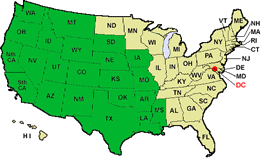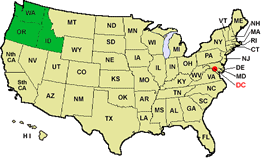|
|
| Destructive Termites in Montana |

| Identification of the main destructive species |
It is critical to identify the species of destructive termites to formulate
an appropriate control program. The main species of destructive
termites in Montana are:
CONTENTS: learn about destructive species of termites - tips on identification
of the timber damage - find out when they swarm in your
local area and how to identify the swarmers, workers and soldiers - learn
about their fascinating biology, life-cycle and behavioural aspects - and receive
professional tips on how best to protect your home from the world's best timber
recycler .... subterranean termites. |
| Arid-land
subterranean termites |
Area of Distribution: The Arid-Land subterranean termite is commonly found
from the Pacific Coast to Indiana, and southwards from Montana to lower
California, Texas, and Mississippi. It is by far the most common and destructive
termite in Arizona.
Identification of Swarmers and Soldiers: In locations below 4,000 feet the
Arid-land termite swarms between January and March. Above 4,000 feet, they
usually swarm in June and July. The swarmers are about 1/3” long with
wings, and 1/5” long without wings. Their wings are almost whitish,
with brown veins in the fore area. Swarmers are dark brown to black in color.
The soldiers are 1/4” long, with jaws that are nearly straight. They
resemble the jaws of the desert termite but are slightly thicker.
Biology and Habits: The Arid-land subterranean termite has been found living
in sand dunes, as well as at altitudes above 7,000 feet in the Rocky Mountain
states. It is also found in moist river low lands and along streams and
canyons, but essentially it is a desert or prairie species. Arid-land subterranean
termites naturally occur in deserts where they attack creosote and greasewood
bushes as well as buildings and other timber structures.
|
Area of distribution: This species is found from central California to British
Columbia and eastward into Idaho, Nevada and Montana. Primarily a forest
dwelling termite this termite is the common termite found in the Californian
mountains. Higher and drier altitudes are preferred, ranging up to 9,000
feet above sea level.
Identification of Swarmers and Soldiers: Soldiers are similar in appearance
to the Pacific dampwood termite, but with longer heads with straighter sides.
The swarmer is a darker brown than the Pacific dampwood termite.
Identification of Timber Damage: The appearance of the damage inflicted
upon timbers by this species is very similar to the Pacific dampwood termite.
Biology and Habits: This species is very similar in habit to the Pacific
Dampwood termite. This species will attack wood of all types throughout
its range. Timbers in contact with the soil or structures built near or
over water are common targets. This species is known to be very tolerant
of moist conditions, even being found in pilings subject to tidal flooding.
Colony size varies but may contain as many as 4,000 individuals.
Colony growth is aided by the production of secondary reproductives. Like
other termites this species aid in the spreading of wood decay fungi, the
spores of which are carried in the gut and on their bodies. A well established
colony will produce winged reproductives which may infest nearby timber.
|
| Published by Fumapest Group © copyright 1995
-
|
|











